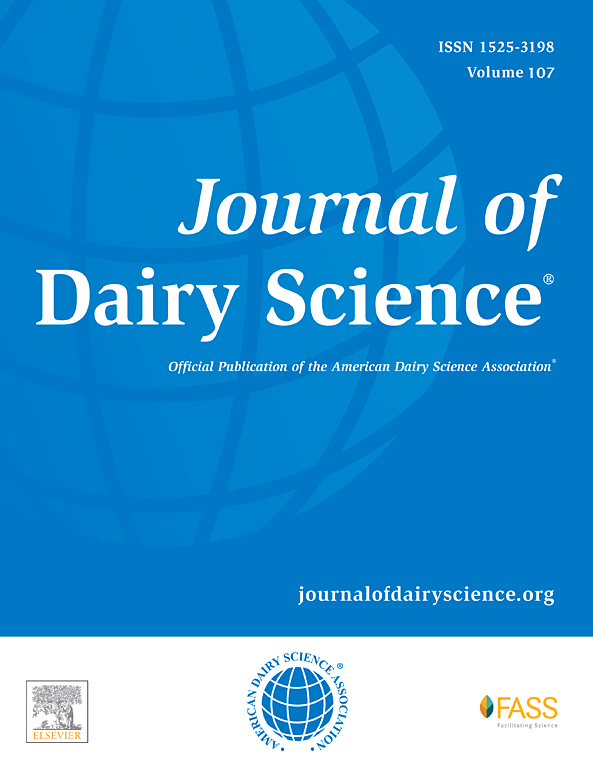奶山羊幼羊血清和成年初乳中免疫球蛋白 G 的遗传和环境决定因素
IF 4.4
1区 农林科学
Q1 AGRICULTURE, DAIRY & ANIMAL SCIENCE
引用次数: 0
摘要
免疫能力是乳用反刍动物健康和恢复能力的关键因素。本研究旨在研究哺乳动物出生后不久血清中的免疫球蛋白G浓度和初乳中的免疫球蛋白G浓度,分别作为被动免疫传递和初乳质量的代表,从而为选择提供新的健康和抗逆性指标。我们分析了在法国国家农业研究院实验农场饲养的 424 只雌性羔羊和 203 只初产山羊的数据。采用径向免疫扩散技术分别测量了羔羊血清和山羊初乳中的IgG浓度。我们使用线性模型确定了血清和初乳中IgG浓度的变化因素,并监测了出生后5周内的健康状况,以衡量被动免疫转移对羔羊健康的影响。我们发现,血清 IgG 水平对后躯清洁度评分(消化不良的代表)以及鼻腔和眼部分泌物有明显影响。正如预期的那样,出生后几天内的 IgG 吸收对于确保母体向幼体的被动免疫转移和提供免疫保护至关重要。我们估算了初产山羊仔羊血清 IgG 浓度和初乳特征的遗传参数。仔羊血清 IgG 的遗传率与零无显著差异。这个低值(SE 值较大)可能是由于样本量有限,而且可能没有考虑到较大的环境变异性。特别是,我们无法调整儿童摄入的 IgG 量,而这可能会对血清 IgG 以及遗传率估计值产生重大影响。初乳性状的遗传率为中等,IgG浓度、IgG质量和初乳量的估计值分别为0.25(±0.16)、0.35(±0.16)和0.25(±0.16)。由于数量较少,产奶量的遗传相关性显示出较高的标准误差。不过,估计结果表明,产奶量与初乳中的 IgG 浓度之间存在负遗传相关性(rg = -0.44 ± 0.33),这可能与初乳总量的正相关性有关。首次估算出的显著遗传率证明山羊初乳质量存在遗传控制,并为该物种的选择提供了机会。本文章由计算机程序翻译,如有差异,请以英文原文为准。
Genetic and environmental determinants of immunoglobulin G in kid serum and adult colostrum of dairy goats
Immune competence is a key factor in the health and resilience of dairy ruminants. The aim of this study was to study IgG concentration in serum shortly after birth and in colostrum of lactating animals as proxy of passive immune transfer and colostrum quality, respectively, and thus provide new health and resilience indicators for selection. Data from 424 female kids and 203 primiparous goats, reared on an INRAE experimental farm, were analyzed. The IgG concentration was measured in kid serum and goat colostrum, respectively, using the radial immunodiffusion technique. Linear models were used to identify factors of variation in serum and colostrum IgG concentration, and health events were monitored for 5 wk after birth to measure the effect of passive immune transfer on kids' health. We found a significant effect of serum IgG level on hindquarters cleanliness score (as a proxy of digestive troubles) and nasal and ocular discharge. As expected, the absorption of IgG in the days following birth is essential to ensure the passive transfer of immunity from the mother to the youngster, and provide immune protection. Genetic parameters were estimated for serum IgG concentration in kids and for colostrum characteristics in primiparous goats. Heritability of serum IgG in kids was not significantly different from zero. This low value, with large SE, may be due to the limited sample size and large environmental variability likely not accounted for. Especially, we could not adjust for the amount of IgG that was ingested by the kid, which can have a significant effect on serum IgG and possibly on heritability estimates. Heritability of colostrum traits were moderate, with estimates of 0.25 (±0.16), 0.35 (±0.16), and 0.25 (±0.16) for IgG concentration, IgG mass, and colostrum volume, respectively. Genetic correlations with milk production showed high standard errors due to small numbers. However, estimates suggest a negative genetic association between production and IgG concentration in colostrum (genetic correlation = −0.44 ± 0.33), probably linked to a positive association with total colostrum volume. The significant heritabilities that were estimated for the first time demonstrate the existence of genetic control of colostrum quality in goats, and open up opportunities for selection in this species.
求助全文
通过发布文献求助,成功后即可免费获取论文全文。
去求助
来源期刊

Journal of Dairy Science
农林科学-奶制品与动物科学
CiteScore
7.90
自引率
17.10%
发文量
784
审稿时长
4.2 months
期刊介绍:
The official journal of the American Dairy Science Association®, Journal of Dairy Science® (JDS) is the leading peer-reviewed general dairy research journal in the world. JDS readers represent education, industry, and government agencies in more than 70 countries with interests in biochemistry, breeding, economics, engineering, environment, food science, genetics, microbiology, nutrition, pathology, physiology, processing, public health, quality assurance, and sanitation.
 求助内容:
求助内容: 应助结果提醒方式:
应助结果提醒方式:


